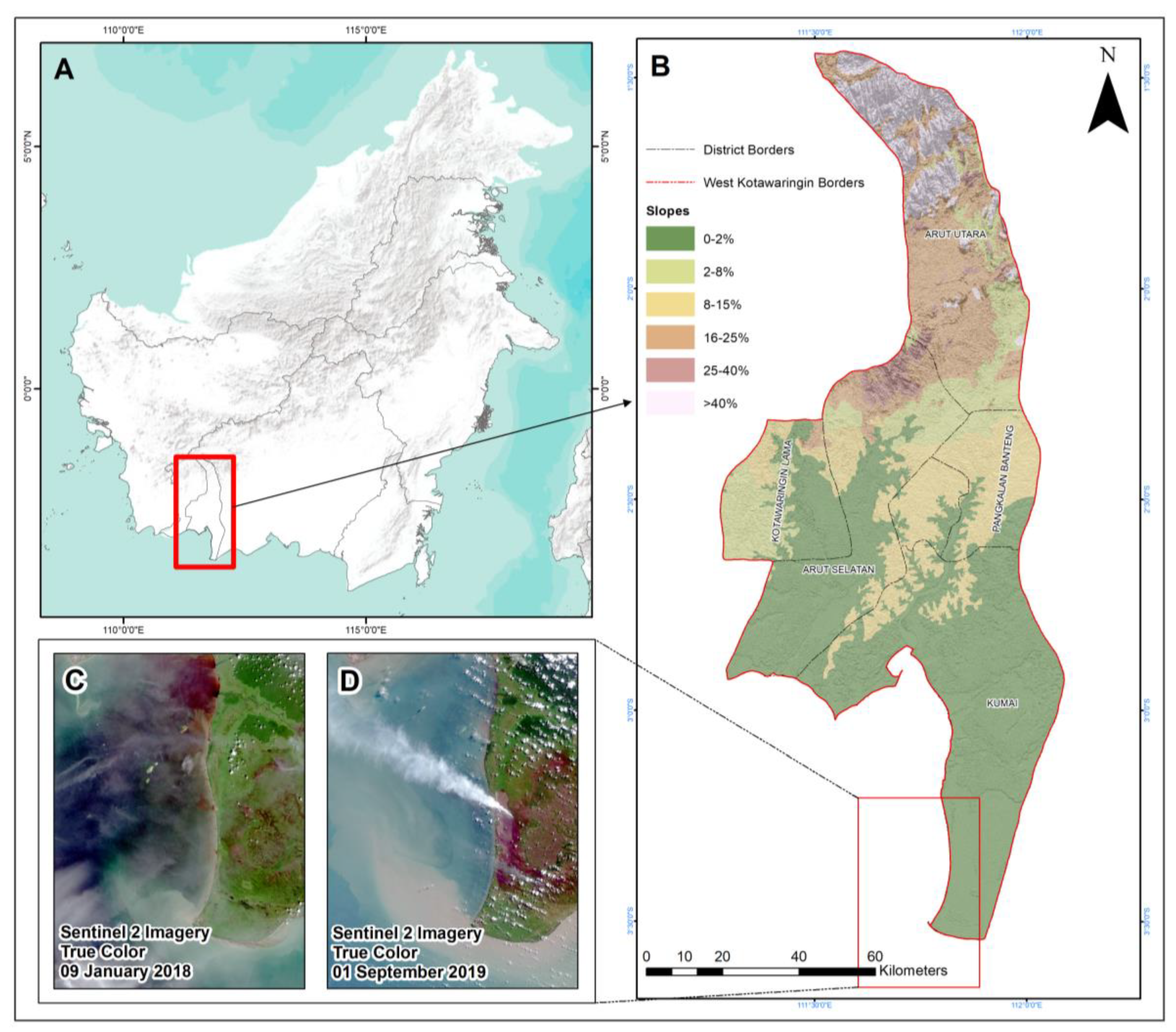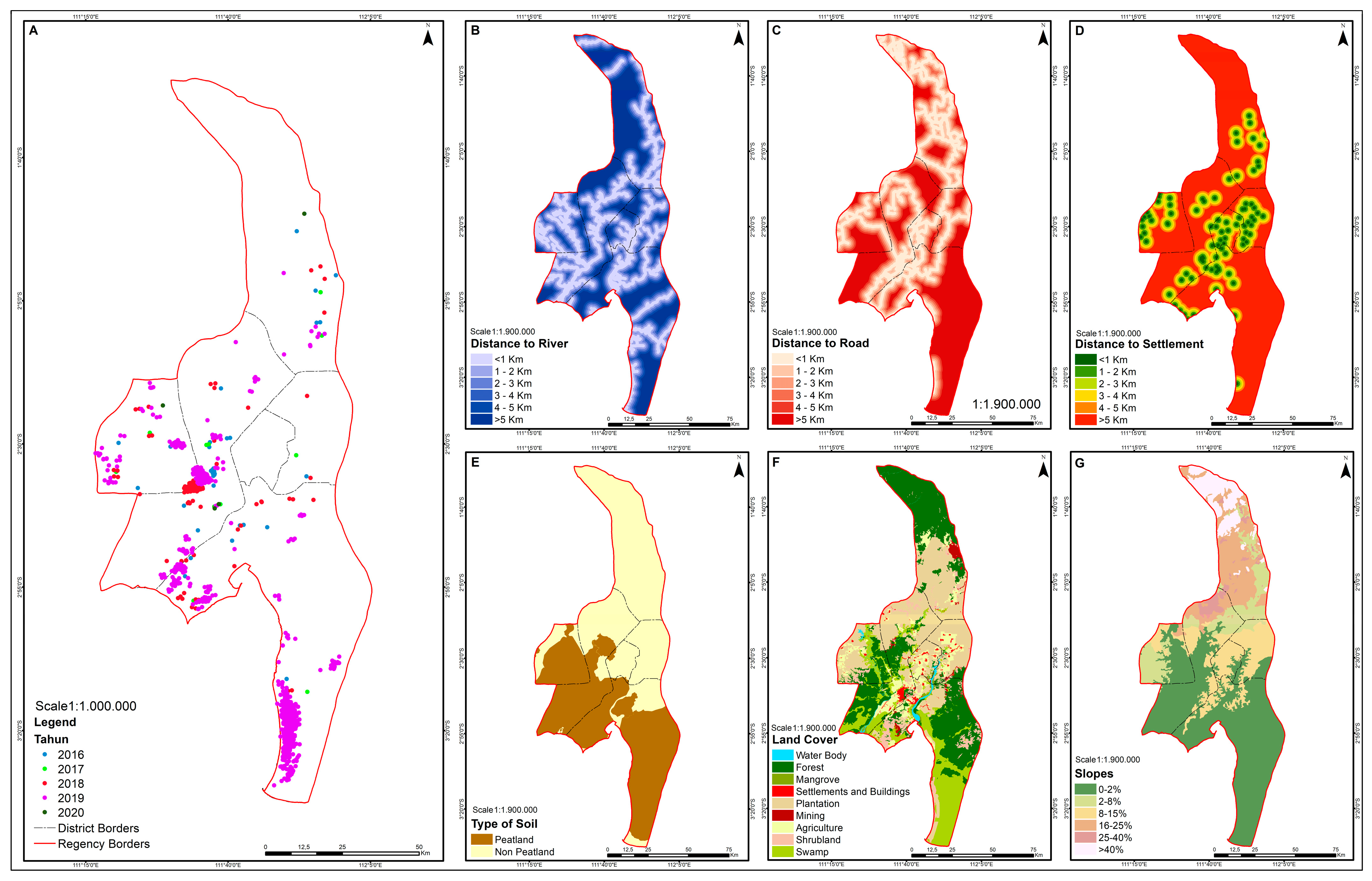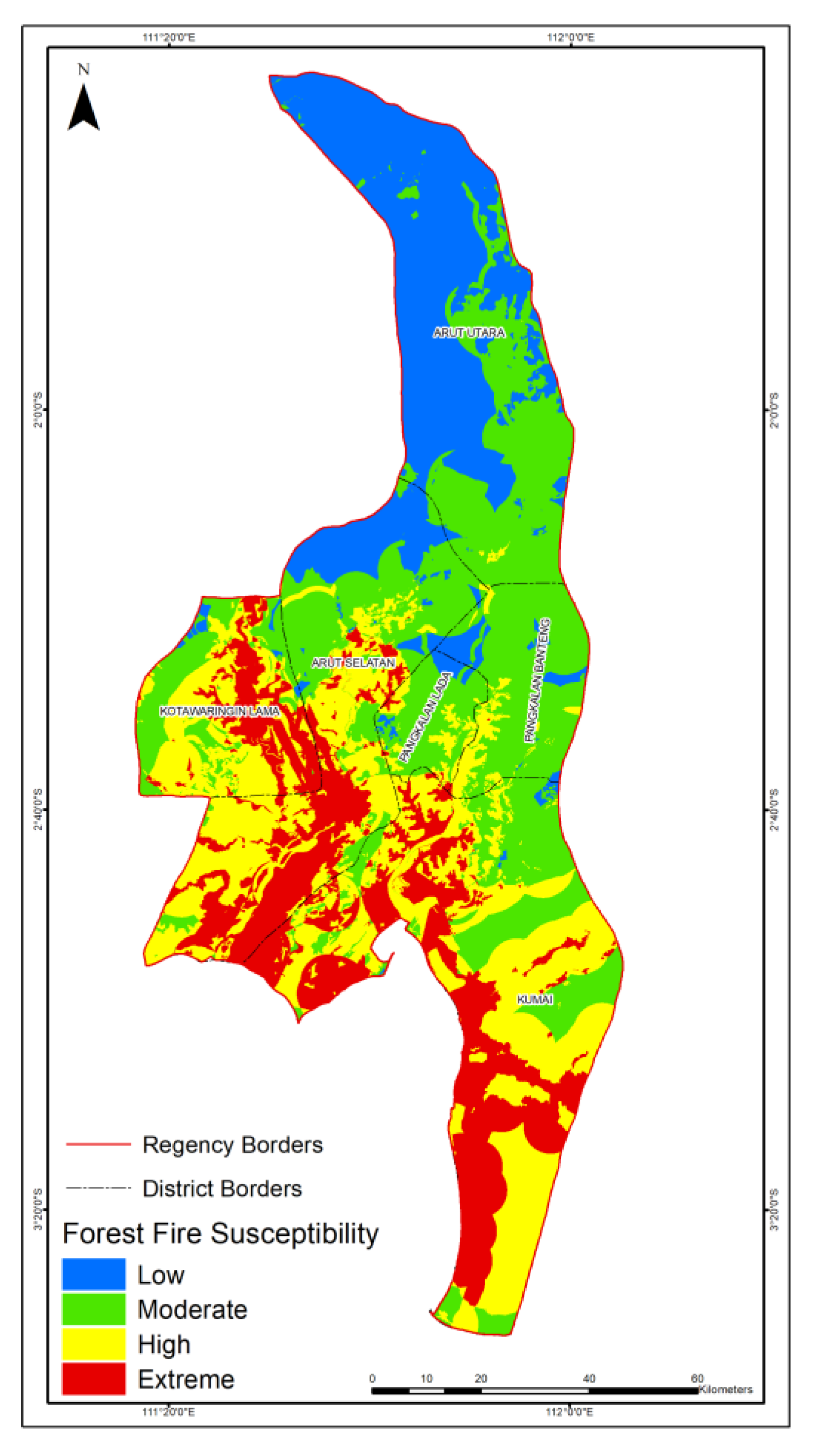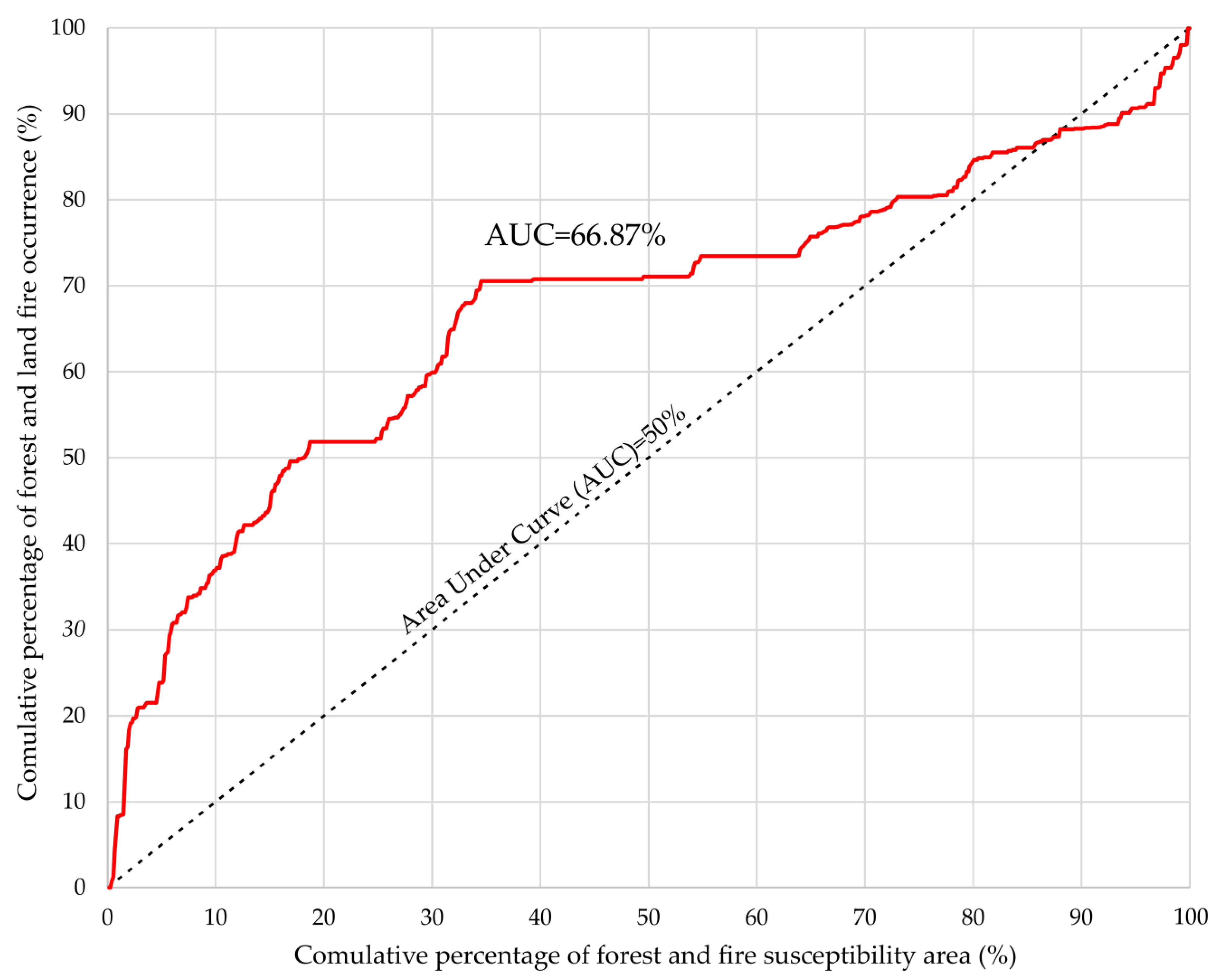Spatial Modeling of Forest and Land Fire Susceptibility Using the Information Value Method in Kotawaringin Barat Regency, Indonesia
Abstract
1. Introduction
2. Materials and Methods
2.1. Study Area
2.2. Data Sources
2.2.1. Hotspot Datasets
2.2.2. Independent Data
| Factors | Classes | Source of Data | Year | Examples of Studies |
|---|---|---|---|---|
| Distance to river | <1 km 1–2 km 2–3 km 3–4 km 4–5 km >5 km | Geospatial Information Agency of Indonesia | 2012 | [26,27,28,29] |
| Distance to road | <1 km 1–2 km 2–3 km 3–4 km 4–5 km >5 km | Geospatial Information Agency of Indonesia | 2012 | [26,27,29,30] |
| Distance to settlements | <1 km 1–2 km 2–3 km 3–4 km 4–5 km >5 km | Geospatial Information Agency of Indonesia | 2012 | [26,27,28,29,30] |
| Type of Soil | Peat Non-Peat | Ministry of Environment and Forestry | 2019 | [28] |
| Landcover | Forest Plantation Swamp Agriculture Shrubland Settlements and Buildings Mining Water Body Mangrove | Ministry of Environment and Forestry | 2019 | [27,29,31] |
| Slope | 0–2% (flat) 3–8% (undulating) 9–15% (moderate sloping) 16–25% (hilly) 26–40 (moderate steep) >40% (steep) | Land Use Planning of Kalimantan Tengah Province | 2003 | [26,27,28,30,31] |
2.3. IVM
- If IVM < 0, the possibility of ignition is lower than average;
- If IVM = 0, the possibility of ignition is equal to the average;
- If IVM > 0, the possibility of ignition is higher than average.
2.4. Map Validation
3. Results
3.1. Spatial Distribution of Hotspot
3.2. IVM Result
3.3. The Correlation of Hotspot to the Climate Aspect
3.4. Forest and Land Fire Susceptibility
3.5. Validation Result
4. Discussion
5. Conclusions
Author Contributions
Funding
Data Availability Statement
Acknowledgments
Conflicts of Interest
References
- Hirschberger, P. Forests Ablaze Cause and Effects of Global Forest Fires; WWF: Berlin, Germany, 2016. [Google Scholar]
- Robinne, F.N. Impacts of Disasters on Forests, in Particular Forest Fires; UNFFS: Trabizond, Turkey, 2021. [Google Scholar]
- Tacconi, L. Kebakaran Hutan Di Indonesia: Penyebab, Biaya Dan Implikasi Kebijakan; Center for International Forestry Research (CIFOR): Bogor, Indonesia, 2003; Volume 38. [Google Scholar]
- Thoha, A.S.; Sofyan, M.; Ahmad, A.G. Spatio-Temporal Distribution of Forest and Land Fires in Labuhanbatu Utara District, North Sumatera Province, Indonesia. IOP Conf. Ser. Earth Environ. Sci. 2020, 454, 012081. [Google Scholar] [CrossRef]
- Albar, I.; Jaya, I.N.S.; Saharjo, B.H.; Kuncahyo, B.; Vadrevu, K.P. Spatio-Temporal Analysis of Land and Forest Fires in Indonesia Using MODIS Active Fire Dataset; Springer International Publishing: Berlin/Heidelberg, Germany, 2018; pp. 105–127. ISBN 9783319674742. [Google Scholar]
- Ardiansyah, M.; Boer, R.; Situmorang, A.P. Preface: International Conference on Recent Trends in Physics (ICRTP 2016). J. Phys. Conf. Ser. 2016, 755, 1–8. [Google Scholar]
- Hartmann, F.; Merten, J.; Fink, M.; Faust, H. Indonesia’s Fire Crisis 2015 A Twofold Perturbation on the Ground. Pac. Geogr. 2018, 49, 1–8. [Google Scholar] [CrossRef]
- Dohong, A.; Aziz, A.A.; Dargusch, P. A Review of the Drivers of Tropical Peatland Degradation in South-East Asia. Land Use Policy 2017, 69, 349–360. [Google Scholar] [CrossRef]
- Ibrahim; Harlen; Sukendi; Siregar, Y.I. Impact of Forest Fire in Peat Land on Land Properties in Pelalawan District Region. IOP Conf. Ser. Earth Environ. Sci. 2019, 383, 012024. [Google Scholar] [CrossRef]
- Herawati, H.; Santoso, H. Tropical Forest Susceptibility to and Risk of Fire under Changing Climate: A Review of Fire Nature, Policy and Institutions in Indonesia. For. Policy Econ. 2011, 13, 227–233. [Google Scholar] [CrossRef]
- Ayuningrum, R.; Nurhayati, A.D. Analysis of the Distribution of Hotspot and Burn Area in Muaro Jambi District, Jambi Province. IOP Conf. Ser. Earth Environ. Sci. 2022, 959, 012057. [Google Scholar] [CrossRef]
- Purnomo, E.P.; Zahra, A.A.; Malawani, A.D.; Anand, P. The Kalimantan Forest Fires: An Actor Analysis Based on Supreme Court Documents in Indonesia. Sustainability 2021, 13, 2342. [Google Scholar] [CrossRef]
- Agus, C.; Azmi, F.F.; Widiyatno; Ilfana, Z.R.; Wulandari, D.; Rachmanadi, D.; Harun, M.K.; Yuwati, T.W. The Impact of Forest Fire on the Biodiversity and the Soil Characteristics of Tropical Peatland. In Climate Change Management; Springer International Publishing: Berlin/Heidelberg, Germany, 2019; pp. 287–303. ISBN 9783319986814. [Google Scholar]
- Salsabila, H.N.; Sahitya, A.F.; Mahyatar, P. Spatio-Temporal Pattern Analysis of Forest Fire Event in South Kalimantan Using Integration Remote Sensing Data and GIS for Forest Fire Disaster Mitigation. IOP Conf. Ser. Earth Environ. Sci. 2020, 540, 012011. [Google Scholar] [CrossRef]
- Shiodera, S.; Atikah, T.D.; Apandi, I.; Seino, T.; Haraguchi, A.; Rahajoe, J.S.; Kohyama, T.S. Tropical Peatland Ecosystems. In Tropical Peatland Ecosystems; Springer: Berlin/Heidelberg, Germany, 2015; pp. 1–651. ISBN 9784431556817. [Google Scholar]
- Sipongi Luas Kebakaran Hutan Dan Lahan Kabupaten/Kota Provinsi Kalimantan Tengah. Available online: http://sipongi.menlhk.go.id/ (accessed on 9 November 2021).
- BPS-Kotawaringin Barat. Kotawaringin Barat Regency in Figures; BPS-Kotawaringin Barat: Pangkalan Bun, Indonesia, 2016. [Google Scholar]
- Hadmoko, D.S.; Lavigne, F.; Samodra, G. Application of a Semiquantitative and GIS-Based Statistical Model to Landslide Susceptibility Zonation in Kayangan Catchment, Java, Indonesia. Nat. Hazards 2017, 87, 437–468. [Google Scholar] [CrossRef]
- Gizatullin, A.T.; Alekseenko, N.A. Prediction of Wildfires Based on the Spatio-Temporal Variability of Fire Danger Factors. Geogr. Environ. Sustain. 2022, 15, 31–37. [Google Scholar] [CrossRef]
- Xu, W.; Yu, W.; Jing, S.; Zhang, G.; Huang, J. Debris Flow Susceptibility Assessment by GIS and Information Value Model in a Large-Scale Region, Sichuan Province (China). Nat. Hazards 2013, 65, 1379–1392. [Google Scholar] [CrossRef]
- Chen, W.; Li, W.; Hou, E.; Zhao, Z.; Deng, N.; Bai, H.; Wang, D. Landslide Susceptibility Mapping Based on GIS and Information Value Model for the Chencang District of Baoji, China. Arab. J. Geosci. 2014, 7, 4499–4511. [Google Scholar] [CrossRef]
- Corominas, J.; van Westen, C.; Frattini, P.; Cascini, L.; Malet, J.P.; Fotopoulou, S.; Catani, F.; Van Den Eeckhaut, M.; Mavrouli, O.; Agliardi, F.; et al. Recommendations for the Quantitative Analysis of Landslide Risk. Bull. Eng. Geol. Environ. 2014, 73, 209–263. [Google Scholar] [CrossRef]
- Verwer, C.; Van Der Meer, P.J. Carbon Pools in Tropical Peat Forest; Alterra: Wageningen, The Netherlands, 2010. [Google Scholar]
- Giglio, L.; Schroeder, W.; Hall, J.V.; Justice, C.O. MODIS Collection 4 Active Fire Product User’s Guide Table of Contents. Revisión B; Department of Geographical Sciences, University of Maryland: College Park, MD, USA, 2018; Volume 1. [Google Scholar]
- Adinugroho, W.C.; Suryadiputra, I.N.N.; Saharjo, B.H.; Siboro, L. Manual for the Control of Fire in Peatlands and Peatland Forest; Wetland International-Indonesia Programme: Bogor, Indonesia, 2005; ISBN 979993737X. [Google Scholar]
- Boonyanuphap, J.; Suratmo, F.G.; Jaya, I.N.S. GIS-Based Method In Developing Wildfire Risk Model (Case Study in Sasamba, East Kalimantan, Indonesia). J. Manaj. Hutan Trop. 2001, VII, 33–45. [Google Scholar]
- Ghorbanzadeh, O.; Blaschke, T.; Gholamnia, K.; Aryal, J. Forest Fire Susceptibility and Risk Mapping Using Social/Infrastructural Vulnerability and Environmental Variables. Fire 2019, 2, 50. [Google Scholar] [CrossRef]
- Ljubomir, G.; Pamučar, D.; Drobnjak, S.; Pourghasemi, H.R. Modeling the Spatial Variability of Forest Fire Susceptibility Using Geographical Information Systems and the Analytical Hierarchy Process. In Spatial Modeling in GIS and R for Earth and Environmental Sciences; Elsevier: Amsterdam, The Netherlands, 2019; pp. 337–369. ISBN 9780128152263. [Google Scholar]
- Thoha, A.S.; Triani, H. A Spatial Model of Forest and Land Fire Vulnerability Level in the Dairi District, North Sumatra, Indonesia. Biodiversitas 2021, 22, 3319–3326. [Google Scholar] [CrossRef]
- Mukti, A.; Prasetyo, L.B.; Rushayati, S.B. Mapping of Fire Vulnerability in Alas Purwo National Park. Procedia Environ. Sci. 2016, 33, 290–304. [Google Scholar] [CrossRef]
- Lamat, R.; Kumar, M.; Kundu, A.; Lal, D. Forest Fire Risk Mapping Using Analytical Hierarchy Process (AHP) and Earth Observation Datasets: A Case Study in the Mountainous Terrain of Northeast India. SN Appl. Sci. 2021, 3, 1–15. [Google Scholar] [CrossRef]
- Julzarika, A.; Aditya, T.; Subaryono, S.; Harintaka, H. Dynamics Topography Monitoring in Peatland Using the Latest Digital Terrain Model. J. Appl. Eng. Sci. 2022, 20, 246–253. [Google Scholar] [CrossRef]
- Nasrul, B.; Maas, A.; Utami, S.N.H.; Nurudin, M. The Relationship between Surface Topography and Peat Thickness on Tebing Tinggi Island, Indonesia. Mires Peat 2020, 26, 1–21. [Google Scholar] [CrossRef]
- Prayoto; Ishihara, M.I.; Firdaus, R.; Nakagoshi, N. Peatland Fires in Riau, Indonesia, in Relation to Land Cover Type, Land Management, Landholder, and Spatial Management. J. Environ. Prot. 2017, 8, 1312–1332. [Google Scholar] [CrossRef]
- Yin, K.L.; Yan, T.Z. Statistical Prediction Models For Slope Instability of Metamorphosed Rocks. In Proceedings of the 5th International Symposium on Landslide, Lausanne, Switzerland, 10–15 July 1988; Volume 2, pp. 1269–1272. [Google Scholar]
- Jade, S.; Sarkar, S. Statistical Models for Slope Instability Classification. Eng. Geol. 1993, 36, 91–98. [Google Scholar] [CrossRef]
- Ba, Q.; Chen, Y.; Deng, S.; Wu, Q.; Yang, J.; Zhang, J. An Improved Information Value Model Based on Gray Clustering for Landslide Susceptibility Mapping. ISPRS Int. J. Geo-Inform. 2017, 6, 18. [Google Scholar] [CrossRef]
- Wubalem, A.; Meten, M. Landslide Susceptibility Mapping Using Information Value and Logistic Regression Models in Goncha Siso Eneses Area, Northwestern Ethiopia. SN Appl. Sci. 2020, 2, 1–19. [Google Scholar] [CrossRef]
- Pourghasemi, H.R.; Beheshtirad, M.; Pradhan, B. A Comparative Assessment of Prediction Capabilities of Modified Analytical Hierarchy Process (M-AHP) and Mamdani Fuzzy Logic Models Using Netcad-GIS for Forest Fire Susceptibility Mapping. Geomatics Nat. Hazards Risk 2016, 7, 861–885. [Google Scholar] [CrossRef]
- Hadmoko, D.S.; Lavigne, F.; Sartohadi, J.; Hadi, P. Winaryo Landslide Hazard and Risk Assessment and Their Application in Risk Management and Landuse Planning in Eastern Flank of Menoreh Mountains, Yogyakarta Province, Indonesia. Nat. Hazards 2010, 54, 623–642. [Google Scholar] [CrossRef]
- Huang, J.; Ling, C.X. Using AUC and Accuracy in Evaluating Learning Algorithms. IEEE Trans. Knowl. Data Eng. 2005, 17, 299–310. [Google Scholar] [CrossRef]
- Thoha, A.S.; Sajarho, B.H.; Boer, R.; Ardiansyah, M. Forest and Land Fires Hazard Level Modeling: Case Study of Kapuas, Central Kalimantan. In Disaster Risk Reduction in Indonesia; Springer International Publishing: Berlin/Heidelberg, Germany, 2017; pp. 539–560. ISBN 9783319544663. [Google Scholar]
- Syaufina, L.; Sitanggang, I.S. Peatland Fire Detection Using Spatio-Temporal Data Mining Analysis in Kalimantan, Indonesia. J. Trop. For. Sci. 2018, 30, 154–162. [Google Scholar] [CrossRef]
- Putra, E.I.; Hayasaka, H.; Takahashi, H.; Usup, A. Recent Peat Fire Activity in the Mega Rice Project Area, Central Kalimantan, Indonesia. J. Disaster Res. 2008, 3, 334–341. [Google Scholar] [CrossRef]
- Tiwari, A.; Shoab, M.; Dixit, A. GIS-Based Forest Fire Susceptibility Modeling in Pauri Garhwal, India: A Comparative Assessment of Frequency Ratio, Analytic Hierarchy Process and Fuzzy Modeling Techniques; Springer: Enschede, The Netherlands, 2021; Volume 105, ISBN 0123456789. [Google Scholar]
- Wen, H.; Guo, Q.; Zeng, Y.; Wu, Z.; Sun, Z. Study on Forest Fire Risk in Conghua District of Guangzhou City Based on Multi-Source Data. Nat. Hazards 2022, 114, 3163–3183. [Google Scholar] [CrossRef]
- Silviana, S.H.; Sahardjo, B.H.; Sutikno, S.; Putra, E.I.; Basuki, I. Basic Information About Tropical Peatland Ecosystems. In Tropical Peatland Eco-Management; Osaki, M., Tsuji, N., Foaed, N., Rieley, J., Eds.; Springer: Singapore, 2021; pp. 3–62. ISBN 9789813346536. [Google Scholar]
- Sumarga, E. Spatial Indicators for Human Activities May Explain the 2015 Fire Hotspot Distribution in Central Kalimantan Indonesia. Trop. Conserv. Sci. 2017, 10, 1–9. [Google Scholar] [CrossRef]
- Syahza, A.; Suswondo; Bakce, D.; Nasrul, B.; Wawan; Irianti, M. Peatland Policy and Management Strategy to Support Sustainable Development in Indonesia. J. Phys. Conf. Ser. 2020, 1655, 1–11. [Google Scholar] [CrossRef]
- Cattau, M.E.; Harrison, M.E.; Shinyo, I.; Tungau, S.; Uriarte, M.; DeFries, R. Sources of Anthropogenic Fire Ignitions on the Peat-Swamp Landscape in Kalimantan, Indonesia. Glob. Environ. Chang. 2016, 39, 205–219. [Google Scholar] [CrossRef]
- Alisjahbana, A.S.; Busch, J.M. Forestry, Forest Fires, and Climate Change in Indonesia. Bull. Indones. Econ. Stud. 2017, 53, 111–136. [Google Scholar] [CrossRef]
- Holden, Z.A.; Swanson, A.; Luce, C.H.; Jolly, W.M.; Maneta, M.; Oyler, J.W.; Warren, D.A.; Parsons, R.; Affleck, D. Decreasing Fire Season Precipitation Increased Recent Western US Forest Wildfire Activity. Proc. Natl. Acad. Sci. USA 2018, 115, E8349–E8357. [Google Scholar] [CrossRef]
- Ganteaume, A.; Camia, A.; Jappiot, M.; San-Miguel-Ayanz, J.; Long-Fournel, M.; Lampin, C. A Review of the Main Driving Factors of Forest Fire Ignition over Europe. Environ. Manag. 2013, 51, 651–662. [Google Scholar] [CrossRef]
- Ciesielski, M.; Bałazy, R.; Borkowski, B.; Szczęsny, W.; Zasada, M.; Kaczmarowski, J.; Kwiatkowski, M.; Szczygieł, R.; Milanović, S. Contribution of Anthropogenic, Vegetation, and Topographic Features to Forest Fire Occurrence in Poland. IForest 2022, 15, 307–314. [Google Scholar] [CrossRef]
- Sari, F. Forest Fire Susceptibility Mapping via Multi-Criteria Decision Analysis Techniques for Mugla, Turkey: A Comparative Analysis of VIKOR and TOPSIS. For. Ecol. Manag. 2021, 480, 118644. [Google Scholar] [CrossRef]
- Ikhsan, A.N. Study of Environmental Susceptibility to Forest Fires in Kotawarin Barat, Kalimantan Tengah Province. Universitas Gadjah Mada: Yogyakarta, Indonesia, 2022; Unpublished Master Thesis. [Google Scholar]






| District | Number of Hotspots | Total | ||||
|---|---|---|---|---|---|---|
| 2016 | 2017 | 2018 | 2019 | 2020 | ||
| Arut Selatan | 18 | 4 | 30 | 112 | 2 | 166 |
| Arut Utara | 5 | 2 | 4 | 9 | 1 | 21 |
| Kotawaringin Lama | 4 | 2 | 81 | 88 | 1 | 176 |
| Kumai | 8 | 2 | 30 | 518 | 0 | 558 |
| Pangkalan Banteng | 1 | 1 | 2 | 0 | 0 | 4 |
| Pangkalan Lada | 0 | 0 | 0 | 0 | 0 | 0 |
| Total | 36 | 11 | 147 | 727 | 4 | 925 |
| Factors | Class | A (km2) | Ai (km2) | ∑HS | ∑HSi | IVM |
|---|---|---|---|---|---|---|
| Distance to river | <1 km | 9554.72 | 2420.75 | 925 | 272 | 0.149 |
| 1–2 km | 1669.82 | 250 | 0.436 | |||
| 2–3 km | 1353.85 | 157 | 0.181 | |||
| 3–4 km | 1078.21 | 118 | 0.123 | |||
| 4–5 km | 822.17 | 96 | 0.187 | |||
| >5 km | 2209.92 | 32 | −1.9000 | |||
| Distance to road | <1 km | 9554.72 | 2220.01 | 925 | 334 | 0.441 |
| 1–2 km | 1520.27 | 226 | 0.429 | |||
| 2–3 km | 1109.82 | 200 | 0.621 | |||
| 3–4 km | 839.63 | 124 | 0.422 | |||
| 4–5 km | 674.59 | 74 | 0.125 | |||
| >5 km | 3190.40 | 69 | −1.499 | |||
| Distance to settlement | <1 km | 9554.72 | 266.21 | 925 | 16 | −0.477 |
| 1–2 km | 670.81 | 53 | −0.203 | |||
| 2–3 km | 795.92 | 76 | −0.014 | |||
| 3–4 km | 766.91 | 63 | −0.164 | |||
| 4–5 km | 737.67 | 54 | −0.280 | |||
| >5 km | 6317.21 | 663 | 0.081 | |||
| Type of soil | Non-peat | 9554.72 | 5108.38 | 925 | 86 | −1.749 |
| Peat | 4446.34 | 839 | 0.667 | |||
| Landcover | Agriculture | 9554.72 | 789.84 | 925 | 77 | 0.007 |
| Plantation | 3005.86 | 242 | −0.184 | |||
| Mining | 109.11 | 4 | −0.971 | |||
| Mangrove | 58.94 | 0 | 0.000 | |||
| Forest | 3231.07 | 92 | −1.224 | |||
| Shrubland | 544.60 | 54 | 0.024 | |||
| Swamp | 1582.48 | 447 | 1.071 | |||
| Settlements and buildings | 133.69 | 9 | −0.363 | |||
| Water body | 99.14 | 0 | 0.000 | |||
| Slopes | 0–2% (flat) | 9554.72 | 4588.41 | 925 | 892 | 0.697 |
| 2–8% (undulating) | 1201.92 | 56 | −0.731 | |||
| 8–15% (moderate sloping) | 1504.51 | 30 | −1.580 | |||
| 16–25% (hilly) | 1325.16 | 7 | −2.908 | |||
| 25–40% (moderately steep) | 237.31 | 2 | −2.441 | |||
| >40% (steep) | 697.41 | 1 | −4.212 |
| Classes | Area (km2) | Percentage |
|---|---|---|
| Low | 1924.41 | 20.14 |
| Moderate | 3207.59 | 33.57 |
| High | 2672.68 | 27.97 |
| Very High | 1750.03 | 18.32 |
| Total | 9554.72 | 100 |
Disclaimer/Publisher’s Note: The statements, opinions and data contained in all publications are solely those of the individual author(s) and contributor(s) and not of MDPI and/or the editor(s). MDPI and/or the editor(s) disclaim responsibility for any injury to people or property resulting from any ideas, methods, instructions or products referred to in the content. |
© 2023 by the authors. Licensee MDPI, Basel, Switzerland. This article is an open access article distributed under the terms and conditions of the Creative Commons Attribution (CC BY) license (https://creativecommons.org/licenses/by/4.0/).
Share and Cite
Ikhsan, A.N.; Hadmoko, D.S.; Widayani, P. Spatial Modeling of Forest and Land Fire Susceptibility Using the Information Value Method in Kotawaringin Barat Regency, Indonesia. Fire 2023, 6, 170. https://doi.org/10.3390/fire6040170
Ikhsan AN, Hadmoko DS, Widayani P. Spatial Modeling of Forest and Land Fire Susceptibility Using the Information Value Method in Kotawaringin Barat Regency, Indonesia. Fire. 2023; 6(4):170. https://doi.org/10.3390/fire6040170
Chicago/Turabian StyleIkhsan, Arman Nur, Danang Sri Hadmoko, and Prima Widayani. 2023. "Spatial Modeling of Forest and Land Fire Susceptibility Using the Information Value Method in Kotawaringin Barat Regency, Indonesia" Fire 6, no. 4: 170. https://doi.org/10.3390/fire6040170
APA StyleIkhsan, A. N., Hadmoko, D. S., & Widayani, P. (2023). Spatial Modeling of Forest and Land Fire Susceptibility Using the Information Value Method in Kotawaringin Barat Regency, Indonesia. Fire, 6(4), 170. https://doi.org/10.3390/fire6040170






